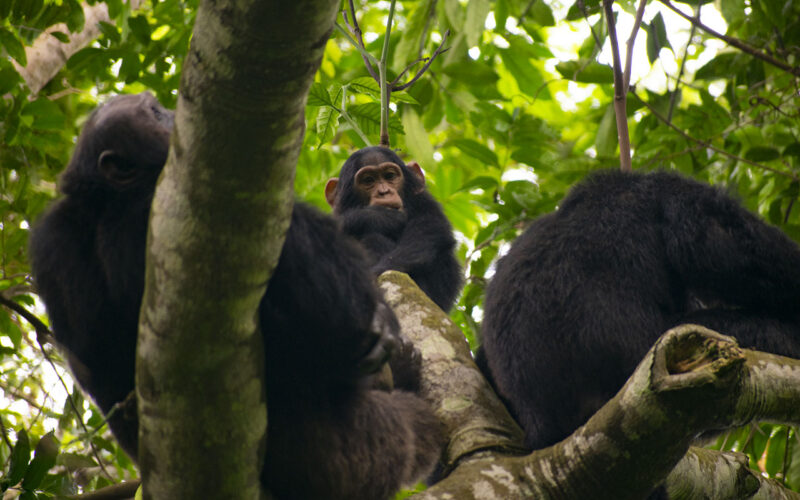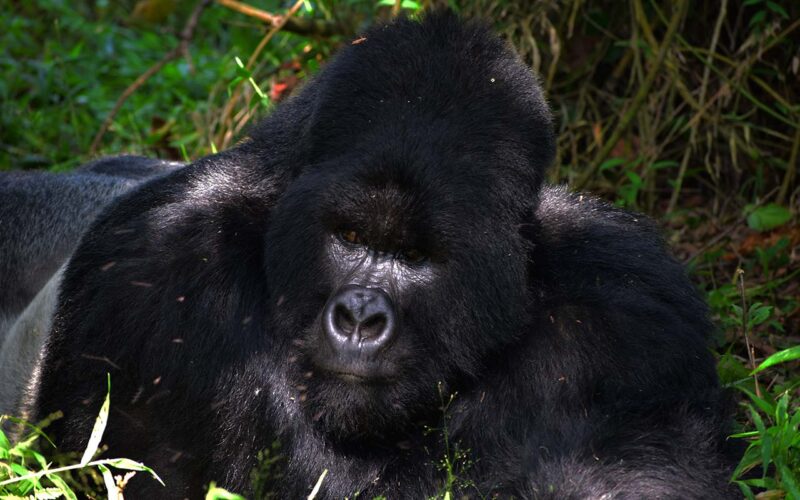Rwanda offers an ultimate primate trekking experience to encounter both the chimpanzee (P.t.schweinfurthii) and the mountain gorilla (G.g.beringei) in their natural montane rainforest homes. A trek experience up-close these two man’s closest relatives in their montane rainforest homes is considered a life-time experience and “the most humbling adventure”.
Mountain gorillas are large, bulky and terrestrial occurring in small family groups of up to 15 individuals comprising of several female, young and blackbacks headed by Silverback at the helm. The chimpanzee on the other hand are smaller than the mountain gorilla, more mobile, loud and highly intelligent apes living in large complex communities of over 70 individuals led by a gang of males with a dominant male on top.
Below is all you need to know and tips to help you plan for that dream combined trek expereince along these man’s closest relatives in their rainforests homes.
Frequently Asked Questions (FAQ) About Mountain Gorilla and Chimpanzee Trekking Experience in Rwanda
Where to track gorillas and chimpanzee in Rwanda
-
Gorilla Trekking Experience at Volcanoes National Park
A trek expereince upclose the bulky mountain gorilla in Rwanda is one of the major highlights for visitors to this attractive country. This takes in Volcanoes National Park, a montane forest lying on the north-west region of Rwanda where the celebrated Dian Fossey that spent decades studying the complex and human-like behaviour of these incredible apes. At Volcanoes National Park, only 10 habituated gorilla family groups are designated for daily trek experience.
On the gorilla trekking experience day visitors must check in at the park’s headquarters at 7am, where they will be led by rangers to any of the habituated gorilla families ranging across the montane ranges. A trek duration varies daily depending on the home range of a designated gorilla family but anywhere between 3-6 hrs is normal. This duration includes a full One hour you are allowed to stay with gorillas, observing, photography and just watching these endangered apes.
It is important to note that mountain gorilla range over high altitudes,visitors are encouraged to prepare well and be in average fitness levels. The park only lies two and half-hour drive from Rwanda’s capital Kigali is well serviced with a variety of accommodations suitable for all budgets including top-notch facilities.
-
Chimpanzee Tracking at Nyungwe National Park
Chimpanzee occur in large communities across the montane forests of Nyungwe National Park located with the Albertine Rift endemic area south-west of Rwanda. In these ancient and vast montane forests, the chimpanzee population now exceed 500 individuals spread in various communities where only three groups are habituated for trekking experience.
On a chimpanzee tracking experience day, an early start of 5am is required to check in at the park visitors’ reception of either Gisakula or Uwinka to meet up the ranger guides. This early start aims at locating where the chimps nested the previous night and thereafter follow them as they forage across their vast territories. On locating the chimps, visitors are only allowed an hour with the apes; to photograph, observe human-like expressions and gain insights into the complex ape society. Trekking duration varies daily, depending on where the home range of the chimpanzee group.
What is best time to track gorillas and chimpanzee in Rwanda
Trek experiences to mountain gorilla and chimpanzee in their rainforest homes in Rwanda is an all-year adventure where the expereince varies daily to local weather variations. Rwanda’s equatorial climate is locally influenced by the country’s high attitudes of over 1500m asl, and other topographic features including, montane forests, wetlands, marshes and lakes. Rwanda has two rain seasons; a long spell from mid Feb-June where most rains fall especially in the highlands and a short spell from mid September-mid December.
The wet season coincide with a low season on the local tourism calendar here, with attractive and price offers from numerous accommodation facilities. This is the right time for dedicated adventurers and naturalists who prefer less or no crowds at all offering exclusive trekking expeditions – an ultimate and personal experience with these apes. To the natural rainforest habitats, the wet season is also a time of abundance especially for the vegetarian mountain gorilla families, for there is fresh foliage to munch about. Therefore, gorilla families do not need to forage far and wide but instead families stick closer within their home ranges making even tracking them more exciting!
To the local scenery, the rains bring in color and freshness while the abundance of food coincides with the breeding season for most local wildlife including birds spicing up the experience. Trekkers also need to be in above-average-fitness-levels, as trails tend to be physical demanding during this season.
The dry season which occurs from June-September with a short spell from December-February coincides with a tourism peak season that brings in a high demand on tracking permits to gorilla and chimpanzee experience.
How to obtain a gorilla and chimpanzee trekking permit in Rwanda
To trek along the mountain gorillas in Volcanoes National Park and along the chimpanzee in Nyungwe Forest National Park one needs to purchase and pay in advance a permit either personally through the RDB portal or through a licensed tour operator. The gorilla trekking permit cost 1500 USD pp while the chimpanzee trek permit goes for 150 USD pp. The permits are high- in-demand especially in peak season and require advance purchase and payment in full.
What is the minimum age required for both gorilla and chimpanzee trekking expereince in Rwanda
The minimum age required for gorilla and chimpanzee trekking expereince in Rwanda is set at 15 years. It is important to note that any persons with potential airborne diseases such as flu or cough will NOT be allowed to trek along the chimpanzee and gorillas, as these primates are extremely susceptible to human diseases.
How fit should one be to trek along the mountain gorillas and chimpanzee in Rwanda
Mountain gorillas range high montane altitudes from 2200m all the way to nearly 4000m on Mt. Karisimbi within Volcanoes NP. Chimpanzee at Nyungwe range within 1700m to 2600m across varied habitats. Trekkers planning for these experiences therefore must be relatively fit and ought to seek their GP’s advice concerning altitude related challenges.

Packing list for a Mountain Gorilla and Chimpanzee trekking expereince in Rwanda
On preparing for the unforgettable trek expereince along gorillas and chimpanzee in Rwanda, it’s important to remember that these endangered apes occur on high-altitude montane forests therefore preparations go beyond the physical. If you come from low altitude countries, seek guidance from your personal general practitioners (GP) concerning altitude related health challenges. That said, gadgets like a camera to capture those moments and a pair of binoculars for closer looks are important. Please Note: All clothing you plan to have on a gorilla and chimpanzee trek should be neutral colors (avoid military clothing) that blend in the natural environment.
For that trek pack;
- Long pants and a sweat long-sleeved shirt (preferably water ploof)
- Pack a raincoat or poncho.
- Comfortable waterproof walking or hiking shoes are a must.
- Gardening gloves are helpful as there will be lots of grabbing and handling.
- Bring along and use that insect repellant.
- A water-proof backpack is essential to protect your electronics on the trek
- On a trek day, remember to carry your packed lunch or a snacks and water (at least 2litres)
- From the trailhead, do take that walking stick along to give you that third hand on the steep ridges.
- From the trailhead, do hire a porter to assist in carrying that heavy backpack.
- Lastly when all is said and done, when that moment comes, take some time to capture the experience but most importantly enjoy and remember where you are!

